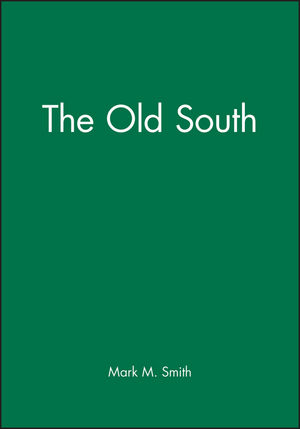|
Textbook
The Old SouthISBN: 978-0-631-21927-9
Paperback
316 pages
December 2000, ©2000, Wiley-Blackwell
 This is a Print-on-Demand title. It will be printed specifically to fill your order. Please allow an additional 10-15 days delivery time. The book is not returnable.
|
||||||
Map: The Old South in 1860.
Chronology.
Introduction.
Part I: A Modern Old South.
Introduction to Documents and Essays.
1. An "Old" Old South.
Sketches of the South Santee, 1797-1798.
A Georgia Planter on the Classical South, 1835.
A Georgia Planter Bemoans the Cost of Slavery, 1846.
An "Old" Old South. (Raimondo Luraghi).
2. An Old South by the Clock.
The Importance of "Early Rising," 1851.
Clock Time and Southern Railroads, 1834.
Plantation Time, 1851.
Timing Slave Labor by the Watch, 1843.
Plantation Time from a Slave's Perspective, 1847.
An Old South by the Clock. (Mark M. Smith).
Study Questions and Further Reading.
Part II: Southern Honor, Southern Violence.
Introduction to Documents and Essays.
3. The Appearance of Honor and the Honor of Appearance.
Affronts to Honor in a Southern Newspaper, 1843.
Public Accusations of Falsehood, 1833.
Codes of Honor and Dueling, 1858.
The Appearance of Honor and the Honor of Appearance. (Kenneth S. Greenberg).
4. Poor, Violent Men in a Premodern World.
A Traveller's Comments on the "Barbarity" of the Southern Frontier, 1816.
A Traveller Observes Techniques of Fighting. 1807.
"Tall talk" Among Ruffians, 1843.
Poor, Violent Men in a Premodern World. (Elliot J. Gorn).
Study Questions and Further Reading.
Part III: Constructing And Defending Slavery.
Introduction to Documents and Essays.
5. Slavery Ordained of God.
Frederick Law Olmstead Recounts Impressions of a Religious Meeting, 1856.
James Henley Thornwell's Defense of Slavery, 1860.
Slavery Ordained of God. (Elizabeth Fox-Genovese and Eugene D. Genovese).
6. Proslavery, Gender, and the Southern Yeomen.
James Henley Thornwell Associates Slavery and Gender Relations, 1852.
John L. Manning's Letter to his Wife, 1860.
George Howe Justifies the Subordination of Women, 1850.
Proslavery, Gender, and the Southern Yeomen. (Stephanie McCurry).
Study Questions and Further Reading.
Part IV: Communities, Cultures, and Economies: Lives of the Enslaved.
Introduction to Documents and Essays.
7. Benefits of the Lowcountry Slaves' Economy.
Charles Manigault's Plantation Journal, 1844.
A South Carolina Rice Planter on the Slaves' Economy, 1858.
Petition and Deposition of Former Slaves, 1873.
Benefits of the Lowcountry Slaves' Economy. (Philip D. Morgan).
8. Ambiguities of the Upcountry Slaves' Economy.
Former Slaves Recall Independent Production.
A Foreign Traveller Observes Wage-earning Slaves, 1860.
Slaves on Trial, 1846.
Ambiguities of the Upcountry Slaves' Economy. (Lawrence T. McDonnell).
Study Questions and Further Reading.
Part V: Selling Southern Bodies.
Introduction to Documents and Essays.
9. The Slave Trader in Image and Reality.
A Boston Minister on Slave Traders, 1855.
A Slaveholder Comments on Traders and Prices, 1846.
A Trader Notes Market Prices for Slaves, 1859.
The Slave Trader in Image and Reality. (Michael Tadman).
10. Reading Bodies, Answering Questions.
A Southern Physician on "Unsoundness in the Negro," 1858-1859.
A Trader Notes How Slaves Affect Their Sales, 1856.
A Former Slave Notes Buyers Reading Bodies, 1855.
A Slave Reads a Buyer, 1858.
Asking Questions and Reading Bodies. (Walter Johnson).
Study Questions and Further Reading.
Part VI: Womanhood in Black and White.
Introduction to Documents and Essays.
11. Breast-Feeding and Elite White Womanhood.
Southern Medical Opinions on Wet Nursing and Breast Feeding, 1850.
Newspaper Advertisements for Wet Nurses, 1859.
A Southern Mother on Child-Rearing, 1844.
Breast-Feeding and Elite White Motherhood. (Sally McMillen).
12. Slave Women and Definitions of Womanhood.
Defining a "Good Wife" and "Good Woman," 1835.
Testimony of Three former Virginia Female Slaves.
Elizabeth Keckley Resists Bondage.
Slave Women and Definitions of Womanhood. (Brenda Stevenson).
Study Questions and Further Reading.
Index.



